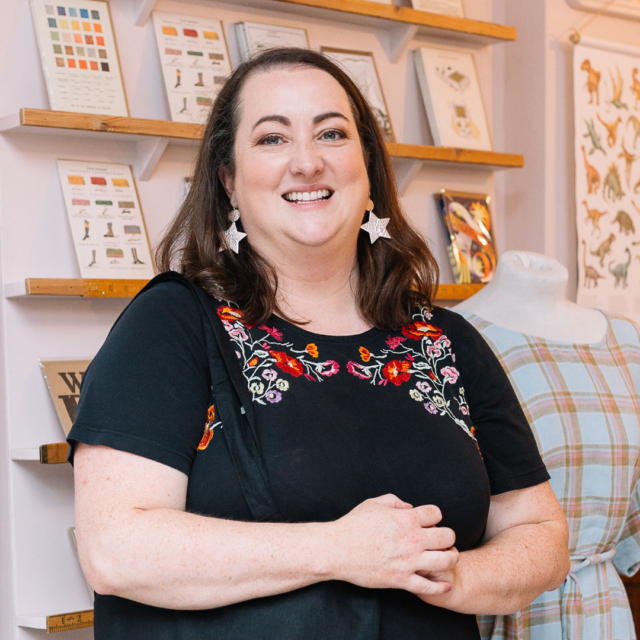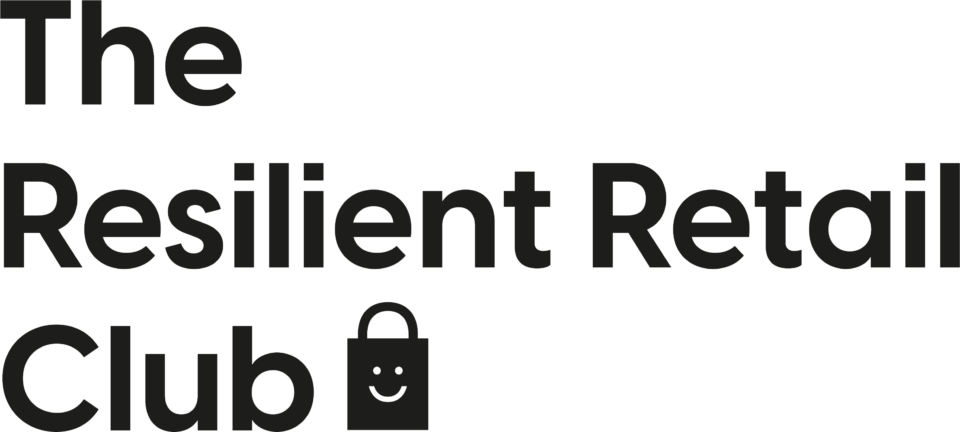Hi, I’m your host, Catherine Erdley. Welcome to the resilient retail game plan. I am the founder of the resilient retail club, which is my membership group and my mastermind for product businesses. If you head over to resilient retail club. com, you can find out more about the club and you can also find out more about my mastermind that will be kicking off again in January.
If you use the code 10 podcast, that’s one zero podcast. Then you’ll be the first to know about every new episode when it comes out. Today, we are on episode number 177, which is all about trends in the retail industry.
Welcome to the Resilient Retail Game Plan, a podcast for anyone wanting to start, grow or scale a profitable creative product business with me, Catherine Erdely. The Resilient Retail Game Plan is a podcast dedicated to one thing, breaking down the concepts and tools that I’ve gathered from 20 years in the retail industry.
and showing you how you can use them in your business. This is the real nuts and bolts of running a successful product business, broken down in an easy, accessible way. This is not a podcast about learning how to make your business look good. It’s the tools and techniques that will make you and your business feel good.
Confidently plan, launch and manage your products and feel in control of your sales numbers and cash flow to help you build a resilient retail business.
Before we get into talking about what my view is for the year ahead, what I believe will be reshaping the retail industry in 2024.
Why it’s so important for product business owners to have an idea of what’s going on in their industry
I want to talk to you a little bit about Why I love to talk about retail trends and why I believe it’s so important for product business owners to have an idea of what’s going on in their industry, because it can feel like a bit of a dry subject, or it can feel to small business owners, like it’s not super relevant.
If you’re not a business that really sees itself as a trend led business, then you may wonder why you even need to worry about what the industry trends are. But I really believe that there are two types of businesses. There are businesses that are very much in a fixed mindset. They really are just focusing on what they’re doing the day to day.
And then there are the type of people who are out there looking for what’s coming next, looking for the opportunities. And I really truly believe that being the kind of person who is proactive, who’s out there looking for things, then that is really. How you can ensure that your business continues to grow and continues to thrive.
So I worked in corporate retail for 17 years before I started my own business. And during that time, I worked for a total of six different retailers. And now of those six, only one of those is actually still trading. The other six, the other five rather went into administration in various different forms.
Some of them still exist as brand names. Some of them still exist in a different format to what they were in when I was working there. But of those six, only one is actually still trading in its. original form that I was working in it. And there’s lots of different reasons for that. It’s been a really tough time in retail and corporate retail for a really, really long time.
But I also think it’s symptomatic of what it was like to work there. They were often toxic work environments. And one of the things that always stood out to me was this lack of real inspirational leadership.
People looking ahead, looking outside, being proactive, looking for ways to move forward. It was very much focused on. Business as usual, just try not to go bust, do your best, but it wasn’t about being out there and trying to understand what was going on and trying to change and inspiring the teams to try new things and change alongside the industry.
And I think that is probably true talking to lots of other friends in the industry. I think that’s probably a really similar experience and a lot of the retail failure that we’ve seen over the last few years. I really think a lot of that has come down to this lack of interest in what’s going on around you and this very much inward focus where everybody in the whole organization was just trying to prove it wasn’t their fault for something that happened.
So for example, one of the things that really got me interested in industry trends in the first place was when I was working at Paperchase. So Paperchase was the company I worked for prior to starting my own business. It now also no longer exists in the format that it existed in when I was working there, which was, it had started off as a very small company and it had grown over the years.
And when I was working there, we had well over 200 stores and well over 100 million pound turnover. And so I worked in the stationary department and the stationary department was really. Very heavily focused on their back to school trade. So Christmas was the main time of year for a lot of the departments, the card department, wrap gifts, everything else.
But for stationary, it was all about back to school. And every month I would have to write a report that went into a lot of detail about the performance of the department over the past month. And that would then get sent up to the board of directors. And one of the things that I had to do in this talk was I had to basically justify the performance, whether it was good, whether it was bad.
And if it was tough, I basically had to explain, almost explain what my team had done, what, what had gone wrong to cause that performance. And it was very much an exercise where you had to explain yourself. And as you can imagine, quite stressful. But we weren’t really allowed to mention outside factors.
And there’s strong reasons for that. I totally do understand why the retail industry was very much focused on that. Everywhere I worked, we would say, you can’t talk about the weather because the thing was, if you went into a Monday trading meeting and you said it was too hot this week or it rained last week, so no one came to stores.
then very quickly you could come up with every week some reason to explain performance. We very much had to focus on the internal, which made sense because that’s what we could control. But what always struck me was this complete lack of any even acknowledgement of what was going on around us. We weren’t even allowed to comment, for example, if The website had done really well, but the stores hadn’t done so well.
We had to focus solely on the stores and the website was a separate entity and we couldn’t look at the whole picture. It was actually completely disallowed. We were only allowed to look at the like for like store picture on its own and explain that as well as then the website is a separate piece. And one of the things that happened one year in particular was that Amazon had really gone for it with their 3 for 2 offer.
So they’d really gone for our bread and butter, if you like, this buying all of your basics for back to school stationery. And yet I was not permitted to even mention this in the report that I had to write implicating myself to the board. Because this was considered to be an external It’s external factors.
So it wasn’t something that I was allowed to reference, even though clearly it had had a major impact. So all of this to say, I found, I used to find that attitude extremely frustrating, although I understood where it came from, because how do you get ahead of things? How do you adapt and understand what’s happening?
If you don’t even acknowledge, you don’t even, you’re not even allowed to acknowledge what was going on to talk about shifts in the way that the customers purchase to talk about. The fact that the way the customer wants to buy has changed. All of those things are really critical to running a business.
And I honestly don’t think it’s a coincidence. I know there are many, many other factors behind businesses going into administration, but an inability to really think about your business in the con and to encourage your teams to think about your business in the context of the wider industry, it’s actually a really dangerous thing to do.
So I started getting really interested in where the industry was going and I didn’t really have that much access to that much information. So I worked in the industry and it wasn’t something they prioritized. They didn’t really prioritize the teams getting educated about retail trends or for example, going to Conferences or anything like that.
There was nothing that we were encouraged to do. And therefore I started my own evening talks. That was how I very, my very first thing that I did to start my own business was I had evening talks where just went on to meet up. I created a group called the future of retail and I had all kinds of interesting people come along.
right from the very first meeting and we talked about what was going on and how the customer was shifting. But it was hard to find that information and that’s why I’m so passionate about sharing this kind of information about small businesses in particular and understanding what it means for them because that was the original start of my business.
It was called Future Retail and it was about retail trends. And originally I focused much more on that kind of content and then over time I realized what people really needed was more information about right now, about the practical side of things, about their profitability, about their business structure, about sales.
But I always wanted all of my work to be informed by the way that the industry was changing so that when I was advising people, we could have one eye on the future as well as what is going on. Currently inside their business. So all of that to say I just wanted to share the story about retail trends and why they’re so important to me and why I so much enjoy putting this content together because I really truly believe it is an important part and something that all of us as small business owners should be aware of because why wouldn’t you want to know how your customer is changing, how they’re shifting, how the overall industry is shifting.
And so I’ve put together four trends. I’m going to go through these very briefly I just touch on them. If you want to find out more, you can head to my website. It’s a blog post on industry trends. And I’ve previously given this as a talk in which I went into more detail. And if you head over to my Instagram and you DM me the words trend 24.
So T R E N D 24, then I will send you the link to get the replay for that talk. So you can definitely do that. And we’ll put the link in the show notes as well. But if you want to head over and DM me, you can get the talk with a lot more detail. So what I’m going to do is I’m going to touch on them.
How did I come up with these trends?
I’d like to share a little bit about how I come up with them.
One of the things I’m very proud of is being a Forbes. com contributor. And as a result, I do get sent a lot of research. So I read through a number of white papers, documents, reports, blog posts, articles, all about the industry. Look at as much detail as I can. And then from that, I pull out what I see are the biggest themes, and then I share them with you through the lens of what it means for a small business.
So everything is about looking at what it means, what the trends are, but then also what they mean for you as a small business owner. So without further ado, let’s talk about for retail trends,
What has been happening in the retail industry
but I’d like to start off by just saying what has been happening. So overall, 2023 has been a little bit easier, a tiny little bit easier.
We’ve seen easing, for example, and things like inflation and we have seen consumer confidence improve from where it was last year. So a report from Goldman Sachs talks about looking into 2024 as the headwinds are easing the economy in the autumn budget is now forecast to grow about 0. 7%, but we are seeing slow recovery of discretionary household income due to continued record high interest rates and also the compound impact of the cost of living crisis.
So, four particular trends then that I want you to think about when it relates to small businesses. They are sustainability and particularly green fatigue. The rise of artificial intelligence, social commerce and personalized communication.
Trend 1: Sustainability, navigating green fatigue
So if we start with sustainability, navigating green fatigue, this can be some saying that no sustainability continues to be a pivotal aspect of retail, but then there’s also green fatigue and growing customer skepticism in 2024 businesses need to really move beyond mere declarations and actually focus on being transparent.
So, a 2024 Euromonitor report on consumer trends has talked about green fatigue is sinking in. Customers have made notable strides in recent years to improve their own personal green credentials as it were, and they want to see organizations to keep placed with them and to show proof of their eco pledges.
What does it mean for your business? Well, really what this means for your business is you need to have a look at what tangible proof you have of your sustainability efforts, and you also need to think about how you can communicate that with your customer. There is an opportunity here for small business owners who put so much time and effort into their sustainability thinking about what they can do for the planet, for the people who work for them and so much more.
So it’s really important that you share that with your customers because they may just either not know what you do or they’re looking for that real tangible proof. And it’s not just lip service.
There’s also been this shift into the idea more of regenerative as opposed to just not being harmful. So regenerative means, for example, that you’re producing an item that is reducing waste, that is, for example, ocean plastics, where things are actually taking plastic out of the ocean and then making things from that.
It is also about things like planting a tree for every order, or not just being carbon neutral, but Actually, how can you be carbon negative as a business owner? The customer is now seeing that as the kind of new standard, but be aware that the customer is vigilant. The customer is skeptical. The customer is thinking that a lot of people are greenwashing that there’s a lot of businesses out there they’re becoming more aware of how they are just basically making things up or exaggerating their green credentials to tune into a More eco conscious customer.
So words are not enough. It’s really thinking about how you can prove that and how you can connect with your customer. I don’t necessarily think this is a bad thing for small businesses.
As I said, I think this could be a real positive because I think then the customer is, is more connected to a small business and more likely to believe them.
Trend 2: The rise of artificial intelligence
So the second trend that I want to talk to you about today is the rise of artificial intelligence. So this is something that you cannot escape.
You have no doubt heard so much about artificial intelligence already. It can, it presents opportunities, but also challenges. The consumer is becoming increasingly used to using artificial intelligence. And what businesses have to do is they have to think about how they can leverage artificial intelligence efficiently, but also preserving that real unique human element of being small business owner.
So Amy Errett, who is a venture capitalist, says that brands will be tasked with finding the balance between creating efficient AI driven processes and maintaining consumer trust derived from meaningful, emotional, relationship driven interactions. A Neuromonitor pointed out that consumers are starting to use AI, so they are expecting brands to keep pace with their exploration of this technology.
ChatGPT was the fastest growing web platform when it launched. It went to over a million active users in just two months, which was until Threads launched in the summer. It was the fastest growing platform ever. So this is something that people are really embracing. And I think small business owners can embrace it too.
I do think there’s a real place for AI in small product businesses, but it really sits in the category of how can you make yourself more efficient. You need to embrace the technology in ways that save you time and money. Many of the tools that you already use, like Canva or Shopify, they are already incorporating magic write technology or magic edit for images.
Have a look at how that can help you. Have a look at how you can speed up some of the really difficult things, like writing 20 different descriptions for the web for a candle. Can you get AI to do that? Can you ask AI to help you come up with blog post ideas, social media ideas? How can you help, how can it help you?
How can it help you brainstorm on the other side? Acknowledge that the customer is going to be craving that human touch. There is a notion that is coming out of a lot of the research that I was doing. which was about this theory that there’ll be a human is premium model coming out, which again, I think is a real plus for small businesses.
And that means that consumers, as much as they love the efficiency, as much as they love the time savings of artificial intelligence, they’re going to really enjoy when they actually get to speak to a human. And that is something that small business owners can really lean into because they’re going to be able to maintain that trust and transparency with the customer.
And, and basically small business owners, they are humans. They are the human element on the end of the DMS or the emails or the phone. And that is something that big businesses are going to be moving away from. So it’s that opportunity to really step into that, that human is premium for, for your customers as a small business, because that’s something you can naturally offer.
But use ai don’t be afraid of it you it think about where you can use it for Efficiencies for time saving and make sure you lean into that so that you are maximizing your time and money Which let’s face it as small business owners. We have very little of and so make sure that you’ve maximized what you can do, but then also thought about how you can make it more human for your customers.
Trend 3: Social Commerce
The third trend is social commerce. Social commerce is the process of checking out through a social media app. This has been something that has been trundling on for a long time, and there’s lots of different elements of this. So just in terms of the stats, the state of social shopping, which was an influencer marketing hub report, talked about how 98 percent of customers plan to utilize Social purchasing at least once this year versus last year when 68 percent of customers claimed they made at least one social media purchase So it’s a huge increase in just the last year.
And this is really, so Saatchi and Saatchi, the advertising agency, they talk about how social commerce is allowing for in app conversion. So they’re allowing people scrolling to become a purchase, a commerce moment, their phrase, which is a great phrase, a commerce moment. In other words, they can buy something.
Global e commerce forecast overall for all online selling. is set to grow by 8. 9 percent in 2024, but social commerce, that specific subset of purchasing through a social media app is expected to grow by 28. 4%. The other element of social commerce is just a continuation of a trend I’ve talked about in previous years about how the customer’s really looking for some form of entertainment from the people that they’re buying from.
There’s a great phrase that came up when I was doing the research for this talk, and then that was permacrisis. I was not, I mean, it’s not a great phrase because it’s a sad fact, but it’s a good way of summing up what’s going on. So we’ve had COVID, we’ve had so many different things over the last few years that it now just feels like this permacrisis. There’s always something going on. It’s global fatigue. And so people are then looking for this idea of what Euromonitor call delightful distractions, heartwarming, playful moments from their favorite brands. And that’s What they want when they’re shopping, they don’t just want a transaction.
They want it, something that can release tension, leave their worries behind. And so this is a whole, a whole idea is that it ties into this, something that I’ve talked to Shopify about a couple of years ago now, where they were talking about the lines getting increasingly blurred between shopping and entertainment.
So this then. Leads into this is, this is a kind of big topic, lots of different elements to it, but then this is where the creator economy comes in. So the creator economy is effectively where people are creating content in their homes, on their phones, and then it, it is becoming increasingly monetized, but it’s still huge area for growth with the creator economy set to hit 500 billion in 2027, uh, which is a huge growth.
So an article in Forbes said that 60 percent of marketers say that content created by influencers or content creators generates more engagement than branded content and 37 percent of consumers trust influencers more than brands. So it also plays into, you have these people whose Natural forte is creating entertaining content, and then you have a customer that wants to buy through entertainment and is entertained by these people and it all just is a natural fit.
So what we may see, what I believe we’ll see in 2024 is an impact on actually the paid advertising. I think broadly speaking, talking to a lot of people that I work with, 2024, 2023 rather has been better for paid advertising than 22. In 2022 very few, if any people I knew were having a really good time with paid advertising.
2023 feels like ROAS has recovered, especially in the meta ads. And it just generally feels better. But however, social commerce, I think we will see a shift out of people putting as much money into paid advertising and then shifting some of that into their social commerce. So there is a decreased trust in advertising.
Insider intelligence that did a forecast of paid ad spend originally forecast 79 billion in paid social spend in 2024 and they’ve actually slashed that forecast by 20 billion. They also believe that affiliate marketing is due to grow 9. 7 percent in 2024 to 15. 7 billion. So effectively, what we’re seeing is almost like this decentralization, people spending less with the actual platforms and they’re spending more In for example giving affiliate codes to content creators who then are able to Go out to their audience talk about your products talk about how much they love them But then share an affiliate link which means that that content creator receives some commission As a as a thank you effectively or as an income stream for promoting your products So what does this mean for your business?
Do you have social commerce enabled? Are people able to check out through your social media? Have a look. If you’re somebody who spends a lot of money on paid spend, is this something that you can look at? Have you engaged with the creator economy? And if this is not your natural forte, I do think the creator economy is a real viable option for people who don’t want to be the face of the brand.
They don’t want to be the person always on camera, but they know the customer wants that connection and they want entertainment. It’s a way of you utilizing other people’s skills to promote your business. And I think it can be something that is used really effectively, but it’s something definitely to think about if you’ve not embraced this in 2023 have a think about it for 2024.
Trend 4: Personalized Communication
And then the final one I wanted to touch on is your personalized communication. So where people are really craving direct and personal communication, then instant messaging platforms like SMS messaging or WhatsApp. That can be a really powerful way forward. And I think we’re going to see a rise in WhatsApp and SMS marketing.
It’s interesting. I’m personally, I’m not a massive fan of getting spammed by SMSs. However, I do feel that that will be different if it was a really lovely small business, a local business that I supported. I was getting some update or information about something going on there via SMS or WhatsApp, then that could be really useful.
The customer is craving connection. The open rates are very impressive. SMS marketing open rates, 98 percent similar 98 99 for WhatsApp business sent through the WhatsApp API. The other thing to think about is chatbots. So chatbots are basically using AI to interact with your customers on your website and they can be used to deliver value and great customer service. So it’s something that is set to also forecast to increase a lot during 2024 is the amount of commerce that actually goes through a chat bot. So again, if this is not something that you’ve experimented with for your business, then I definitely recommend having a think.
So then in 2024, it’s about reexamining your sustainability, embracing artificial intelligence, and especially the efficiencies that it can bring. Leaning into social commerce and thinking about how you have personalized conversations with your customers. There’s so much more to this topic. Do come over to Instagram at resilient retail club. Drop me a note. Let me know what you thought, or DM me the word trends 24. And I will send you the full talk, which goes into even more detail.
And I’d love to hear what you thought about the trends and what you think is going to be ahead for 2024. If you have a moment, of course, to rate and review the podcast, it makes a huge difference. You can rate and review it in Apple Podcasts and you can also rate it in Spotify app. Of course, if you follow or subscribe, then you’ll be the first to know about each new episode, which comes out every Thursday.







